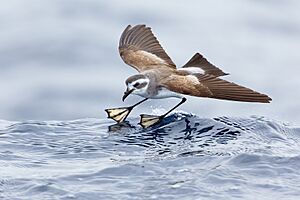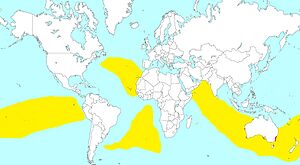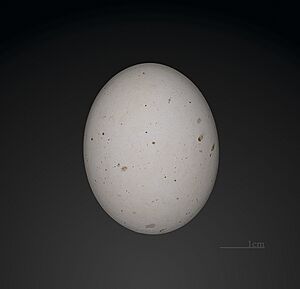White-faced storm petrel facts for kids
Quick facts for kids White-faced storm petrel |
|
|---|---|
 |
|
| Conservation status | |
| Scientific classification | |
| Genus: |
Pelagodroma
|
| Species: |
marina
|
 |
|
| Distribution map of the species | |
| Synonyms | |
|
|
The white-faced storm petrel (Pelagodroma marina) is a small seabird. It is also known as the white-faced petrel. This bird belongs to the austral storm petrel family, called Oceanitidae. It is the only species in its own special group, or monotypic genus, named Pelagodroma.
Contents
What Does It Look Like?
The white-faced storm petrel is about 19 to 21 centimeters (7.5 to 8.3 inches) long. Its wings can spread out 41 to 44 centimeters (16 to 17 inches) wide. It has a light brown or gray back, rump, and wings. Its flight feathers are black.
This bird is white underneath, which helps it stand out from other petrels. It also has a white face with a black mask around its eyes. This mask makes it look a bit like a phalarope. Its unique colors make it one of the easiest petrels to spot and identify when you are out at sea.
How Does It Behave?
When it's not breeding, the white-faced storm petrel lives only out at sea. It rarely comes to land. This makes it a hard bird to see from the shore. You might only spot one near land during very strong storms.
This petrel flies with a smooth, gliding motion. It often "pats" the water with its feet as it picks up tiny food items, like plankton, from the ocean surface. These birds like to be in groups, but they do not follow ships. Like most petrels, they are not very good at walking. They can only shuffle short distances to their nests.
Life Cycle and Reproduction
White-faced storm petrels make their nests on faraway islands. These islands are found in the south Atlantic Ocean, like Tristan da Cunha. They also breed in Australia and New Zealand. There are also colonies in the north Atlantic, on the Cape Verde Islands, Canary Islands, and Savage Islands.
They build their nests in colonies close to the sea. They often use cracks in rocks. Each pair lays just one white egg. For the rest of the year, these birds live out at sea. When they are at their breeding sites, they are very active at night. This helps them avoid predators like gulls and skuas. They even try to avoid coming to land on clear, moonlit nights.
Different Types of White-Faced Storm Petrels
Scientists have found six different groups, or subspecies, of white-faced storm petrels. These groups breed in island colonies across warm and cool regions of the Atlantic, Indian, and southwestern Pacific Oceans.
- P. m. albiclunis – Found near the Kermadec Islands.
- P. m. dulciae – Lives on islands off southern Australia.
- P. m. eadesi – Breeds on the Cape Verde Islands.
- P. m. hypoleuca – Found on the Savage Islands.
- P. m. maoriana – Lives on islands around New Zealand, including the Chatham Islands and Auckland Islands.
- P. m. marina – Found on Tristan da Cunha and Gough Island. This is the original group that gave the species its name.
Status and Conservation
The white-faced storm petrel is found over a very large area. Because of this, it is listed as "Least Concern" on the IUCN Red List of Threatened Species. This means that scientists do not believe it is currently at risk of disappearing.



